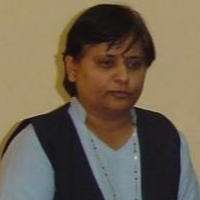
M. S. Joshi
Work place: Department of Computer Engineering, Jawaharlal Nehru Engineering College, Aurangabad, India
E-mail: madhuris.joshi@gmail.com
Website:
Research Interests: Computer systems and computational processes, Pattern Recognition, Operating Systems, Image Processing, Data Mining
Biography
Madhuri S. Joshi is presently working as an Professor, Department of Computer Engineering, Jawaharlal Nehru Engineering College, Aurangabad, M.S., India. She completed her B.E. (Electronics & Telecom) from College of Engineering, Pune (1985), M.Tech(CS) from IIT Madras (1993) and Ph.D. in 2008. Her research interests are Image Processing, Pattern Recognition, Data Mining, Operating Systems. She has published about 23 research papers in Conferences and Journals.
Author Articles
Dual Population Genetic Algorithm for Solving Constrained Optimization Problems
By A. J. Umbarkar M. S. Joshi P. D. Sheth
DOI: https://doi.org/10.5815/ijisa.2015.02.05, Pub. Date: 8 Jan. 2015
Dual Population Genetic Algorithm is an effective optimization algorithm that provides additional diversity to the main population. It addresses the premature convergence problem as well as the diversity problem associated with Genetic Algorithm. Thus it restricts their individuals to be trapped in the local optima. This paper proposes Dual Population Genetic Algorithm for solving Constrained Optimization Problems. A novel method based on maximum constrains satisfaction is applied as constrains handling technique and Dual Population Genetic Algorithm is used as meta-heuristic. This method is verified against 9 problems from Problem Definitions and Evaluation Criteria for the Congress on Evolutionary Computation 2006 Special Session on Constrained Real-Parameter Optimization problem set. The results are compared with existing algorithms such as Ant Bee Colony Algorithm, Differential Evolution Algorithm and Genetic Algorithm that have been used for solving same problem set. Analysis shows that this technique gives results close to optimum value but fails to obtain exact optimum solution. In future Dual Population Genetic Algorithm can produce more efficient solutions using alternative constrains handling technique.
[...] Read more.OpenMP Dual Population Genetic Algorithm for Solving Constrained Optimization Problems
By A. J. Umbarkar M. S. Joshi P. D. Sheth
DOI: https://doi.org/10.5815/ijieeb.2015.01.08, Pub. Date: 8 Jan. 2015
Dual Population Genetic Algorithm is an effective optimization algorithm that provides additional diversity to the main population. It deals with the premature convergence problem as well as the diversity problem associated with Genetic Algorithm. But dual population introduces additional search space that increases time required to find an optimal solution. This large scale search space problem can be easily solved using all available cores of current age multi-core processors. Experiments are conducted on the problem set of CEC 2006 constrained optimization problems. Results of Sequential DPGA and OpenMP DPGA are compared on the basis of accuracy and run time. OpenMP DPGA gives speed up in execution.
[...] Read more.0/1 Knapsack Problem using Diversity based Dual Population Genetic Algorithm
DOI: https://doi.org/10.5815/ijisa.2014.10.05, Pub. Date: 8 Sep. 2014
The 0/1 Knapsack Problem is an optimization problem solved using various soft computing methods. The solution to the 0/1 Knapsack Problem (KP) can be viewed as the result of a sequence of decisions. Simple Genetic Algorithm (SGA) effectively solves knapsack problem for large data set. But it has problems like premature convergence and population diversity. Dual Population Genetic Algorithm (DPGA) is an improved version of Genetic Algorithm (GA) with the solution to above problems. This paper proposes Dual Population GA for solving 0/1 knapsack Problem. Experimental results of knapsack on SGA and DPGA are compared on standard as well as random data sets. The experimental result shows DPGA performs better than knapsack on SGA.
[...] Read more.Other Articles
Subscribe to receive issue release notifications and newsletters from MECS Press journals